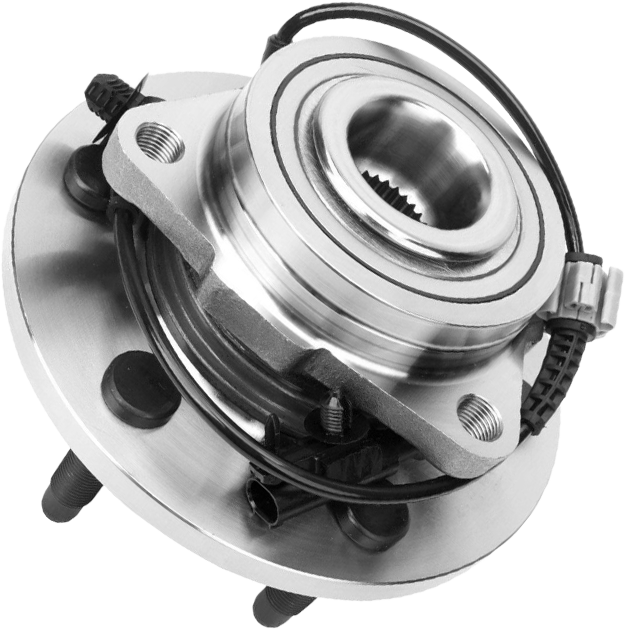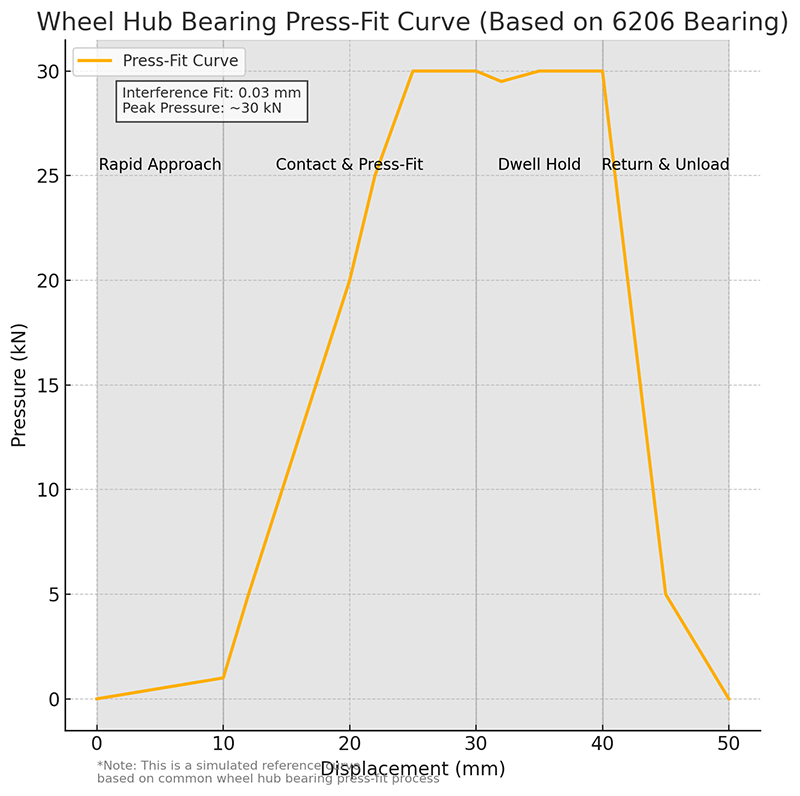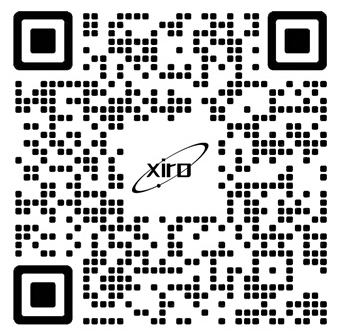The wheel hub bearing press-fit process is a critical step in automotive chassis manufacturing. Its precision directly influences vehicle handling stability, fuel efficiency, and NVH performance (Noise, Vibration, Harshness). As the core component connecting the wheel hub and the knuckle, the bearing must maintain accurate concentricity and proper internal clearance under high-speed, high-load conditions. The quality of press-fitting plays a decisive role in ensuring these parameters.

Wheel Hub Bearing
(For confidentiality purposes, the product images shown are representative illustrations only and do not depict actual client-specific product)
I. Typical Process Challenges and Failure Cases
1. Excessive Preload Leading to Early Bearing Failure
Case Study:
A German OEM experienced mass failures in rear wheel hub bearings. Within just 20,000 km of operation, the failure rate reached 35%. Post-analysis showed 68% of the defective bearings suffered asymmetric raceway wear with misalignment angles up to 0.8°, resulting in a recall costing over ¥48 million.
Root Cause:
Traditional hydraulic presses exhibited ±18% instantaneous axial force fluctuation, resulting in actual preload exceeding the design limit by 23%. FEA simulation revealed a maximum-to-minimum contact stress ratio of 2.5:1 (MPa), significantly reducing fatigue life.
2. Microscopic Raceway Damage Due to Off-Center Loading
Case Study:
A North American automotive brand reported that 12% of early bearing failures were due to raceway dents. Scanning Electron Microscopy (SEM) showed that a misalignment angle of 0.8° led to a stress concentration factor of 1.8.
Root Cause:
Conventional presses have guide gaps ≥0.1 mm between ram and columns, resulting in >15 N·m of bending moment during pressing. Without real-time load centering correction, misalignment between shaft and bearing is not compensated.
3. Low Efficiency in Multi-Model Line Changeovers
Case Study:
A component supplier had to switch among six different hub types within an 8-hour shift. Traditional mechanical jigs took 147 minutes per changeover due to rigid locating modules with a flange diameter tolerance of only ±15 mm.
Root Cause:
The flange diameters ranged from φ72 mm to φ114 mm—a 42 mm span—while mechanical limit blocks could only accommodate ±15 mm. Repositioning required disassembly of 12 bolts with repeatability of ±0.2 mm, failing to meet the ±0.05 mm requirement. Manual entry of process parameters caused an 18% error rate, leading to systematic shaft misalignment (0.5–1.2°).
4. Quality Risks Due to Lack of Process Traceability
Case Study:
In 2024, an EV manufacturer recalled 120,000 wheel hub assemblies due to incomplete press-fit parameter records. Post-failure analysis showed 68% had pitting on raceways, but the lack of curve data prevented verification of over-force conditions.
Root Cause:
Traditional press systems only log the final press force, omitting critical displacement-time or force-time curves—especially during fine-press stages. As a result, there was no way to confirm whether transient overloading caused the defect, leading to full-batch recalls.
II. XIRO Electric Servo Press Solutions
1. High-Precision Closed-Loop Control
The XIRO electric servo press integrates high-accuracy pressure sensors and linear encoders to form a full closed-loop control system. When a sudden pressure spike exceeds 10% of the set limit, the system automatically switches to slow-speed mode to prevent shock. This ensures the three core performance targets in hub bearing assembly:
Press-fit Precision: Interference fits are controlled within 0.02–0.05 mm, with a pressure range of 20–80 kN depending on bearing specs.
Coaxiality: Post-assembly radial runout ≤0.03 mm (measured on the hub flange) to avoid noise and wear during high-speed rotation.
Damage-Free Assembly: A six-stage press-fit curve includes slow pre-pressing (≤5 mm/s) to avoid raceway damage.
Application Example:
A production line using a six-stage curve (Rapid Feed / Contact Detection / Fine Press / Secondary Press / Dwell / Return) with PID + feedforward control achieved:
Positioning Accuracy: ±0.01 mm (ISO 9283)
Pressure Accuracy: ±0.5% Full Scale

Wheel Hub Bearing Press-Fit Curve (Based on 6206 Bearing (Data source: XIRO)
2. Adaptive Press-Fit Technology
XIRO supports 64-step programmable logic without mechanical reconfiguration. This allows full customization of speed, force curve, and dwell time to meet various bearing specifications:
Pre-Pressing: Rapid advance at 20 mm/s to reduce cycle time.
Fine Pressing: Switches to force-controlled mode (5–10 N/s ramping) to ensure proper interference without impact loads.
Dwell Phase: Maintains constant pressure for 3–5 seconds to eliminate elastic deformation.
Application Example:
In a major automotive assembly line, 18 hub types were supported. Changeover time reduced from 147 minutes to 15 minutes. First-pass yield improved from 85% to 99.6%, and CPK increased from 1.0 to 1.67.
3. Full Process Traceability and Data Capture
XIRO electric servo press system incorporates a built-in linear encoder (±0.01 mm accuracy) and pressure sensor (±0.5% accuracy) for real-time acquisition of force-displacement curves, speed, dwell time, and more. Key features:
Sampling Rate: ≥1000 Hz
Data Logging: Full-process storage of critical values (peak force, displacement offset)
Connectivity:
SQL database export
Seamless MES system integration
Automatic anomaly alerts and curve archiving
Each hub bearing press-fit operation is 100% traceable, fully complying with ISO and IATF quality requirements for automotive process control.
Conclusion
Precision in wheel hub bearing press-fit directly impacts safety, NVH performance, and product lifecycle. The traditional hydraulic approach is increasingly inadequate for modern manufacturing demands, especially with multi-variant production and quality traceability requirements. XIRO’s electric servo press technology, through high-precision closed-loop control, adaptive parameterization, and full-process digital traceability, represents the future of intelligent, zero-defect hub bearing assembly.
Discover how XIRO Electric servo press technology can help your production line reduce scrap, accelerate changeovers, and improve traceability. Contact us or visit YouTube channel to explore 100+ servo press applications demos across the automotive, aerospace, and precision manufacturing sectors.






